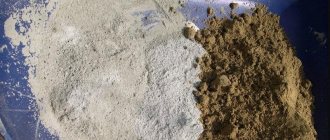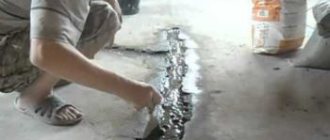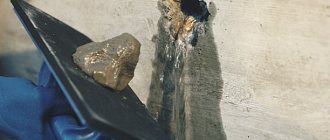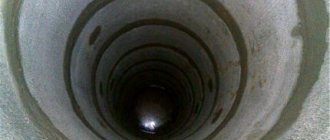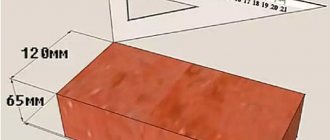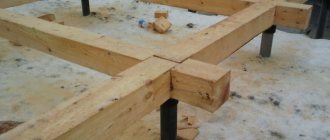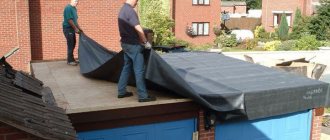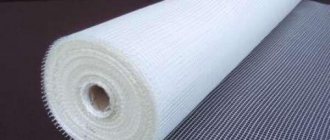Many apartment owners are faced with the phenomenon of holes in the walls or ceiling. This situation especially often manifests itself during preparation for renovation, when, after removing the wallpaper, holes are discovered in concrete floors, or when entering new buildings that completely require finishing. Filling holes in the walls and ceiling is an important part of the complex of preparatory work, after which you can begin finishing work: laying tiles, gluing wallpaper, painting or whitewashing the ceiling.
Diagram of holes in a concrete floor.
Holes in concrete walls can appear for various reasons, which also determines the method of sealing them.
Holes from screws and nails
Holes from nails or screws (self-tapping screws) are the most common reason for repairing concrete walls.
This is largely due to the fact that in Soviet times it was customary to fasten nails and screws using large wooden plugs. Holes for them were often made with a brace or bolt. Such holes were quite large, reaching up to 2 centimeters in diameter.
Despite the fact that there may be several such holes in the apartment, filling them is not particularly difficult. To carry out the work you will need:
- plaster or repair composition;
- spray bottle with water or brush;
- primer;
- putty knife.
If there is still a plug in the hole, it must be removed before filling the hole. You can do this in two ways:
- Screw a screw or self-tapping screw into the cork, and then pull it out with a nail puller along with the cork.
- Drill out the plug with a drill. For work, it is advisable to use drills for wood or metal.
When the hole is free of the plug, you should spray it a little from a spray bottle. You can also treat the hole with a brush dipped in water with the addition of a primer. Then the finished gypsum or repair mixture is taken on a spatula and smeared into the hole. When the mixture tightly fills the entire hole, the sealing is ready and all that remains is to wait until the solution dries completely.
Repair of fabric stretch ceiling
Methods for repairing fabric directly depend on the nature of the damage:
- Small hole, puncture. Repairing seamless fabric surfaces is much easier than PVC films. For example, a small hole can simply be sewn up using a strong nylon thread and a thick needle. The darning area is subsequently masked using paint that best matches the color of the main surface of the ceiling. Acrylic paint is most suitable for this.
Repairing a small hole on a fabric stretch ceiling using a needle and nylon thread
- Small cut. You can disguise such damage by carefully gluing both halves of the cut using tape or adhesive tape on the back side of the canvas. If everything is done correctly, the cut will be practically invisible.
- Major damage. If the hole in the fabric ceiling is such a size that it cannot be sewn up neatly, you should apply a patch. The ideal option is to use the same material as on the ceiling (it is for this reason that scraps of fabric that remain after installation are not recommended to be thrown away). If it was not possible to find an identical fabric, you need to take the most suitable option, subsequently touching up the repair area. The patch is cut so that it covers the dimensions of the damage along all edges with a margin of approximately 5 mm.
Applying a patch to a fabric stretch ceiling: the patch is cut out (2), transparent glue is applied to it (3), the patch is glued and carefully smoothed (4).
It is best to fix the patch over the hole with transparent adhesives (for example, super glue): when dry, they retain elasticity, which makes it possible to avoid deformation of the fabric. Rubber-based adhesives have also worked well. After gluing, the strip of fabric must be carefully smoothed out, otherwise it will wrinkle in the future. In this case, excessive pressure should be avoided so that the ceiling does not deform.
Small potholes
Concrete floor laying diagram.
As with traffic holes, potholes are quite common in concrete. Typically, the reasons for their appearance can be various construction works, such as drilling or blows with a sledgehammer. Also, the appearance of small potholes can be caused by a violation of the isotropy of the material or painting the wall along the cracks.
Small potholes are sealed using the same algorithm as sealing plug holes.
The pothole is treated with water with the addition of a primer, and then covered with a repair compound, gypsum or plaster with a spatula. If necessary, a dried pothole can be sanded with coarse sandpaper with a grain size of 80-100.
Redevelopment with an opening in the ceiling
Making holes in the floor slab is one of the priority services of the Buravchik . The installation of holes in hollow core slabs is carried out by operators with extensive experience working at customer sites in Moscow and the Moscow region.
The installation of technological holes in hollow and hollow floor slabs is carried out using diamond drilling/hole drilling installations with water supply to the installation without much noise and dust.
Prompt operator visit to the customer’s site within 24 hours
We make holes in the slabs - without dust and noise!
Order installation of holes in floor slabs +7(495)991-81-26
Page menu:
- Installation of holes in ceilings prices
- Additional work
- Helpful information
- Our works
♦ Performing non-standard tasks
An individual approach to the object, the experience of our employees and the competent selection of tools give us the opportunity to solve non-standard tasks posed by the customer.
♦ Compliance with work deadlines
The updated arsenal of imported equipment allows us to reduce order completion times by connecting additional tools to work on site.
♦ Affordable prices
We work at attractive prices and offer discounts for construction organizations.
Deep defects
Filling deep potholes is already somewhat difficult, and its implementation should be approached responsibly and carefully.
Work must begin with the preparation of a repair mixture suitable for use on concrete. In this case, the mixture should have the texture of plasticine. To do this, you should use solutions that have the ability to dry quickly - gypsum cement or sand concrete (3 parts cement to 1 part sand). If the work is carried out in a dry room, the use of gypsum is allowed. But in this case, the hole should be sealed in no more than 1-2 minutes, until the mixture dries.
The repair mixture is carefully placed into the hole. To clean a hole from crumbled putty, many experts recommend using a vacuum cleaner. In this case, the likelihood of small dust particles remaining on the walls of the hole is reduced to zero and the sealing will be more successful.
Scheme for sealing cracks in the ceiling.
As soon as the solution has set, a second layer of the mixture is applied using a façade spatula. After this, the pothole is left to dry for 2 days. If severe shrinkage occurs, you will need to apply another layer of the mixture.
Repair of PVC stretch ceiling
Repairing holes in a suspended PVC ceiling is much more difficult due to the lower strength of the material.
It is best to invite professional craftsmen for such work, pasting a piece of tape over the damage before they arrive.
In cases where it was decided to carry out the repairs yourself, it is necessary to act depending on the size of the damage and its location.
Minor damage near the wall
In this case, the location of the defect can simply be hidden inside the static profile by additionally stretching the fabric. To do this, pull out the fixing bar (harpoon) from inside the profile using a spatula, removing the edge of the sheet next to the defect (sometimes there may be fixing wedges under the bar, which can be removed by simply pulling them down). Next, with extreme caution, cut off the strip of film with damage, trying not to snatch off too much.
Repairing minor damage to a suspended ceiling. Part 1.
If necessary, you can glue the canvas overlapping to the harpoon with colorless glue.
Applying colorless glue to a harpoon for gluing a stretch ceiling
To thread the fabric back, you need to warm it up a little with a household hairdryer: thanks to this, the material will gain the necessary elasticity for stretching. The edge of the material inserted inside the profile is secured from above with an overlay strip. If, at the end of the procedure, wrinkles appear on the decorative surface, they need to be heated with a hairdryer to completely smooth them out.
Repairing minor damage to a suspended ceiling. Part 2.
Damage far from the edge of the film
If the hole in the stretched PVC sheet is located more than 15 cm from the wall, the stretching method will not work. In order not to spend money on buying a new film, you can cover the tear area with a lamp or ventilation grill. To do this, make a neat cutout in the right place according to the size of the new element, reinforcing the edges of the cutout with a special thermal ring made of plastic (the ring will strengthen the edges of the film to prevent further deformation). The excess film inside the ring is cut off. Next is the installation of a ceiling lamp, chandelier or grille.
Closing a hole in a stretch ceiling: covering the hole with a ventilation grill
It should be said that the easiest way is with a ventilation grille, since in the case of a lamp, you need to somehow connect the wiring to the place where it is installed. It is practically impossible to do this without removing the tension film. A more favorable situation is when there are already spotlights on the ceiling, and one of them is located not far from the resulting hole. In this case, instead of completely dismantling the canvas, you can do with partial dismantling (like what was mentioned in the previous section). Having unscrewed the film from the edge closest to the damage, it is necessary to mount the platform above the hole on a rough base, and then connect the power wires from the nearest lighting fixture to it.
Rupture of the connecting seam
Defects of this kind mainly occur due to the use of low-quality film or due to errors in its welding. In any case, responsibility falls entirely on the company that installed the system. Any local repairs are impossible here: the damaged canvas will have to be replaced with a new one. In situations where the warranty period for a suspended ceiling has already expired, installing a new film will cost less than the initial installation (the frame is already there, and the rough base has been prepared in advance).
The canvas has come off the wall along with the profile
The reason for this defect is a violation of the system installation technology. All you need to do is replace the failed profile with a new one and secure it well. After this, decorative fabric is tucked inside it.
Making holes in the ceiling price
If you have a need to organize the installation of holes in floor slabs and you would like to know the prices (cost of services) for the installation of technological holes in hollow-core floor slabs at your facility, please call our company office by phone: +7(495)991-81-26.
Our managers will promptly and efficiently provide consultation regarding the installation of holes in floor slabs in your premises in Moscow or the Moscow region.
Prices are indicated in Russian rubles. for 1 centimeter of drilling/drilling a hole in the ceiling
| Hole diameter mm. | Brick | Concrete | Reinforced concrete |
| Ø 25-52 | 16 | 18 | 20 |
| Ø 62-72 | 18 | 22 | 24 |
| Ø 82-102 | 20 | 24 | 26 |
| Ø 112-122 | 22 | 26 | 32 |
| Ø 132-142 | 24 | 30 | 34 |
| Ø 152-162 | 30 | 34 | 36 |
| Ø 172-202 | 36 | 40 | 44 |
| Ø 225-252 | 44 | 52 | 58 |
| Ø 302-325 | 48 | 58 | 68 |
| Ø 352 | 62 | 74 | 96 |
| Ø 402 | 86 | 94 | 124 |
| Ø 452 | 96 | 116 | 138 |
| Ø 502 | 112 | 132 | 156 |
| Ø 502+ individually | — | — | — |
- Making holes in floor slabs - prices are approximate.
- Making holes in hollow core slabs, the price will pleasantly surprise you.
- Installation of technological holes in floor slabs in concrete, price from the manufacturer.
For large volumes, individual pricing policy.
Requirements for the Customer:
- Connection point to a 220V power supply (power at least 2.5 kW);
- Availability of a source of clean water on site;
- Providing markings for all types of work.
Increasing factor for diamond drilling (drilling) and cutting:
| K1-water drainage during diamond drilling/drilling | 1,05 |
| K2 - high reinforcement of walls/floors | 1,25 |
| K3 - horizontal drilling/drilling and diamond cutting | 1,10 |
| K4 - diamond drilling/drilling in hard-to-reach places | 1,15 |
| K5 - drilling/drilling/cutting at height (at a height of over 2.0 meters) | 1,10 |
| K6 - for diamond drilling/drilling/cutting in M400 concrete | 1,15 |
| K7 - for diamond drilling/drilling, cutting in concrete grade M500 | 1,25 |
| K8 - when performing work without the possibility of supplying water to the drilling/cutting site | 1,10 |
| K9 - when working in winter conditions, excluding the cost of coolant | 1,10 |
| K10 - with a subsequent increase in drilling depth by step - 50cm from the base 1m | 1,05 |
| K11 - if it is necessary to carry out work from 22.00 to 8.00 (night time) | 1,10 |
| K12 - if it is necessary to carry out work on weekends and holidays | 1,25 |
| K13 - when carrying out work in dangerous places and at heights | 1,10 |
Making holes in floor slabs at an angle

